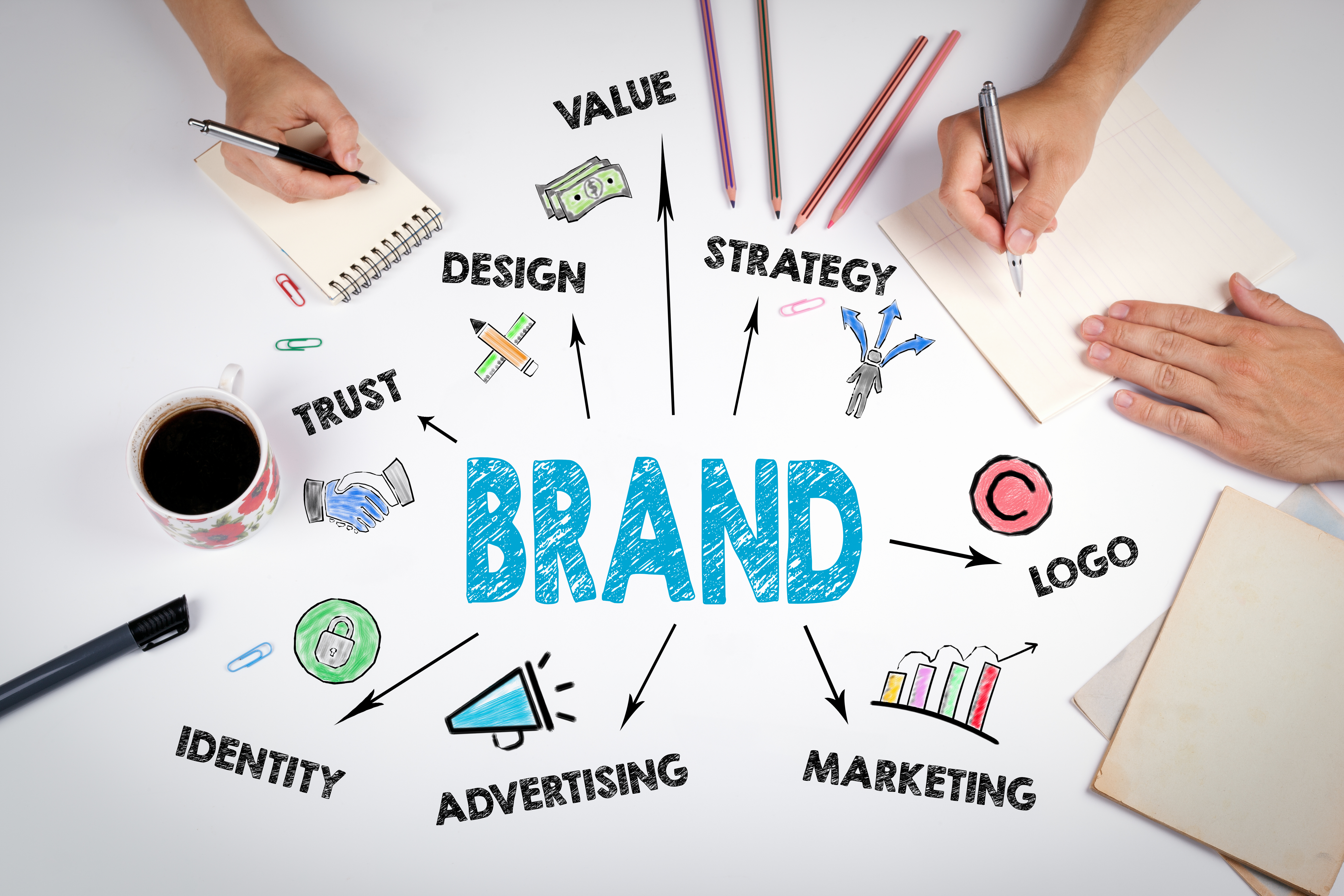Branding is a powerful tool in the business world. It's more than just a logo or a catchy slogan; it's the essence of your business, the heart of your story, and the promise you make to your customers.
But what exactly goes into creating a brand, and how can you build one that truly represents your business? Let's explore this in our step-by-step guide to branding your business.
Jump to:
What is Brand Identity?
Brand identity is the visible elements of a brand, such as colour, design, and logo, that identify and distinguish the brand in consumers' minds. It's like the face of your business - the first thing people see and the last thing they remember. But it's not just about looks; your brand identity reflects your business's values, mission, and personality.
The Key Elements of Brand Identity:
- Visual Elements: These include your logo, colour scheme, and typography.
- Brand Voice: This is how you communicate with your audience, including your language and tone.
- Brand Values: The core principles that guide your business.
How to Create a Brand Identity
When designing a brand identity, it’s important to consider how each element represents your business. Here are seven simple steps to guide you:

1. Understand Your Business
To effectively brand your business, it's essential to start with a clear understanding of its fundamental principles. Delve into what makes your business unique; these elements are the pillars that will shape your brand's identity and guide its journey forward:
Core Values: Identify the values that are at the heart of your business. Are you about equality, sustainability, or community building?
Unique Selling Proposition (USP): What sets your business apart? This could be your product quality, customer service, or a unique problem-solving approach.
Vision and Mission: Clearly define your business goals and how you plan to achieve them. This helps in aligning your brand identity with your business objectives.
2. Know Your Audience
From creating detailed customer personas to engaging with them directly, understanding customers’ needs and preferences is key to developing a brand identity that resonates:
Customer Personas: Create detailed profiles of your ideal customers. What are their interests, lifestyles, and challenges?
Market Research: Understand the demographics and psychographics of your target market. This helps in tailoring your brand identity to meet your audience's specific needs and preferences.
Engagement: Interact with your potential customers through surveys or social media to get direct feedback about their expectations.
3. Create a Logo and Colour Scheme
Designing your brand's visual identity is key for reflecting your brand's personality and ensuring consistency across all platforms:
Logo Design: Your logo should be simple, memorable, and reflect your brand’s personality. Consider hiring a professional designer to ensure quality.
Colour Psychology: Colours evoke emotions and convey messages. Choose a colour palette that aligns with the feelings you want to associate with your brand.
Versatility: Ensure your logo and colour scheme are versatile enough to work across various mediums, from digital platforms to print materials.
4. Develop Your Brand Voice
Developing a distinctive brand voice is a fundamental step in connecting with your audience. You can achieve this by:
Consistency: Maintain a consistent tone across all your communications. This includes your website content, social media posts, advertisements, and customer service interactions.
Personality: Decide if your brand voice will be formal, casual, humorous, or authoritative. This should reflect your brand’s personality and resonate with your target audience.
Messaging: Craft key messages that communicate your brand’s values and USP. Use these messages consistently in your marketing and communications.

5. Build Your Online Presence
Establishing a strong online presence is key to enhancing your brand's visibility and engagement. Here’s how this is possible:
Website: Create a professional website that showcases your brand identity through its design, content, and user experience.
Social Media: Utilise social media platforms to engage with your audience. Tailor your content to fit each platform while maintaining your brand voice and visual style.
Content Strategy: Develop a content strategy that supports your brand identity. This could include blogs, videos, infographics, or podcasts.
6. Consistency Across All Touchpoints
Maintaining consistency across all touchpoints is essential for a cohesive brand experience, such as:
Branding Materials: Ensure that your brand identity is consistently applied across all materials, including business cards, brochures, and packaging.
Employee Training: Use effective leadership skills to train your employees to effectively understand and represent your brand identity. This includes customer interactions, sales processes, and how they present themselves.
7. Monitor and Evolve
Embrace the dynamic nature of your brand identity by monitoring and evolving, following these steps:
Feedback and Adaptation: Regularly seek customer feedback and be prepared to adjust your brand identity as your business grows and market trends change.
Brand Evolution: Understand that a brand identity isn’t static. It should evolve with your business, reflecting changes in your strategy, market, or audience preferences.
Creating a brand identity involves discovery, creativity, and strategic thinking. Remember, a strong brand identity is more than just aesthetics; it's the essence of your business communicated to the world.
What is a Brand Guideline Document?

Once you’ve decided on your brand identity, creating your brand guideline is the next essential step. This document outlines how to use your brand's elements, ensuring consistency across all your marketing materials and communications. Think of it as a rulebook for your brand's look and feel.
- Logo Usage: Instructions on how to use your logo, including size, colour, and placement.
- Colour Palette: Details of your brand's colour scheme and how to use them.
- Typography: Guidelines on the fonts to use for different types of content.
- Tone of Voice: How your brand communicates with your audience.
Brand Guideline Example Table
Presenting the brand guideline document in a table format can make it more structured and easier to navigate. Here's how it could be laid out:
| Section | Contents |
| 1. Introduction | - Overview of the brand and the purpose of the guidelines. - Brand essence, including core values, mission, and vision. |
| 2. Logo Usage | - How to use the logo, including sizing, spacing, and what not to do. - Variations for different contexts (e.g., monochrome, vertical, horizontal). |
| 3. Colour Palette | - Primary and secondary colour palettes with specific colour codes (RGB, CMYK, Pantone, Hex). - Guidance on how to use these colours for brand consistency. |
| 4. Typography | - Primary and secondary typefaces. - Guidelines on font usage for different contexts (headings, body text, print, digital). |
| 5. Imagery Style | - Style of photography and graphics that reflects the brand's essence. - Examples of appropriate and inappropriate imagery. |
| 6. Brand Voice | - Description of the brand’s tone of voice. - Examples of how to convey this tone in various types of communication. |
| 7. Application | - Examples of brand elements in use, like on business cards, websites, or advertisements. - Best practices for cohesive brand representation. |
| 8. Digital Guidelines | - Specifics for digital applications, including website design, social media, and email marketing. - Instructions for online branding consistency. |
| 9. Miscellaneous | - Additional elements like iconography, patterns, or any other brand-specific elements. - Special cases or exceptions. |
| 10. Contact | - Contact information for further inquiries or approval processes. |
Recommended for you!
Best SellersExample of a Brand Identity
A great example of a brand identity is Apple. Their clean, minimalist design and innovative and user-friendly approach make their brand instantly recognisable. From its iconic logo to its sleek product design and distinctive advertising style, every element of Apple's brand identity works together to convey its core values of innovation and simplicity.
Centre of Excellence: Empowering Your Branding Journey
At Centre of Excellence, we understand the power of branding. We offer a comprehensive Introduction to Branding Diploma Course that guides you through building a successful brand. Whether you’re a beginner with a side hustle or are looking to refine your existing brand, our course provides you with the necessary tools and knowledge.
- Tailored Learning: Our courses are designed to suit people of all levels and experiences.
- Expert Guidance: Learn from industry experts who know the ins and outs of successful branding.
- Flexible Learning: Study at your own pace, from anywhere in the world.
For a limited time, you can enrol in this course for just £29! Don’t miss this opportunity to empower your brand and make a lasting impact.












